If you're new here, you may want to subscribe to my RSS feed. Thanks for visiting!
As the name of this website implies, we like to keep things nourishing and natural. I recently spent some time reading up on store-bought pectin and I was very unhappy to discover the jams I have been making for my family have been tainted with GMOs. I had unknowingly been contaminating the carefully sourced fruit and pricey turbinado sugar with the very things I strive to avoid, and I hadn’t even given it a second thought.
Most brands exclaim breathlessly, “All natural pectin” or “Made from real fruit”. And this is true – it does originate from fruit. Sound okay, right? Don’t be deceived. This misleading label makes it sound as though this is nothing more than some powdered fruit.
Here’s the label from the Ball pectin that was lurking in my pantry.
Storebought pectin contains additives that are most likely genetically modified. Dextrose is generally made from corn products (GMOs that are absolutely SOAKED in glyphosate). It is made from cornstarch, the main ingredient in good old High Fructose Corn Syrup.
Don’t let anyone tell you that citric acid is “just Vitamin C”. It is derived from GMO mold.
Not only does storebought pectin contain unsavory ingredients, but it is also very highly processed. According to Wikipedia, this is how it is produced:
The main raw materials for pectin production are dried citrus peel or apple pomace, both by-products of juice production. Pomace from sugar beet is also used to a small extent.
From these materials, pectin is extracted by adding hot dilute acid at pH-values from 1.5 – 3.5. During several hours of extraction, the protopectin loses some of its branching and chain length and goes into solution. After filtering, the extract is concentrated in vacuum and the pectin then precipitated by adding ethanol or isopropanol. An old technique of precipitating pectin with aluminium salts is no longer used (apart from alcohols and polyvalent cations, pectin also precipitates with proteins and detergents).
Alcohol-precipitated pectin is then separated, washed and dried. Treating the initial pectin with dilute acid leads to low-esterified pectins. When this process includes ammonium hydroxide, amidated pectins are obtained. After drying and milling, pectin is usually standardized with sugar and sometimes calcium salts or organic acids to have optimum performance in a particular application. (source)
So, if you want to avoid GMOs and processed foods, what’s a homemade-jam making mama to do?
Jam has been around for thousands of years. The first known book of jam recipes was written in Rome in the 1st century (source). Since, I’m pretty sure our ancestors didn’t have those handy little boxes of Sure-Jel or Certo sitting in their pantries, I set out to learn how they made a thick delicious preserve to spread on their biscuits.
My first attempt at breaking up with the box was to make my own pectin with green apples. While I ended up with a tasty product, it wasn’t really jam-like. It’s possible, considering the time of year, that the apples were too ripe to allow this to work for me. You can find instructions on how to make your own pectin from apples HERE.
I continued to read recipes and methods from days gone by. It soon became clear that adding pectin wasn’t really necessary at all. In days past, the sugar and the fruit worked hand-in-hand to create the desired consistency. If you are determined to use pectin (some fancier jams are nicer with a thicker set-up) I strongly recommend Pomonas Universal Pectin, a non-GMO, non-toxic pectin. Don’t be put off by the higher price – you can get several batches of jam from one packet of pectin, so it works out to a similar cost as the yucky stuff.
I combined bits from a few different methods and finally came up with a jam that the entire family was happy with. In comparison with the boxed pectin jam, it doesn’t gel quite as much, but after trying this jam, the texture of the other now seems slightly artificial to me. This produces a softer preserve with an incredibly intense fruit flavor. As well, when using this method, you don’t get that layer of foam that you have to skim off the top like you do with the boxed pectin method.
Blueberry Jam without Added Pectin
It’s blueberry season where I live, and we’ve been walking to a neighboring berry patch and picking until our fingers are stained with purple. 27 pounds of blueberries later, we have delicious jam and a byproduct of blueberry syrup.
After 3 tasty batches of jam-that-wasn’t-jam, I combined a few methods and came up with one that will work with basically any type of fruit.
You will need:
- 7 pounds of fruit (approximately 14-20 cups)
- 5 cups of organic sugar (You can run coarse turbinado sugar through the food processor to get a finer texture)
- 1/4 cup + 2 tbsp of lemon juice
- Piece of clean cotton fabric for draining I really like these flour sack towels
for straining cheese or purees. This will be permanently stained, so don’t use something you want to keep pretty.)
Instructions:
1.) Prepare your fruit. For our berries, this meant washing them and sorting them, removing little leaves and twigs, as well as berries that were shriveled. We left the odd green berry in, because less ripe fruit has more naturally occurring pectin than ripe fruit. I used 7 pounds of blueberries for this batch of jam.
2.) Mash, finely chop, or puree your fruit. I used a blender to puree half of the fruit, and a food processor to finely chop the other half. We prefer a rough puree texture.
3.) Pour this into a large crock or non-reactive bowl, layering your fruit with 3 of the cups of sugar. I used the ceramic insert from my crock-pot for this.
3.) Leave the fruit and sugar mixture in your refrigerator overnight. The juice from the fruit will combine with the sugar and form a slightly jelled texture. Some liquid will separate from the sugar and fruit.
4.) The next day, line a colander with a piece of fabric. Place the colander into a pot to catch the liquid from the fruit and sugar mixture. Pour your fruit and sugar mixture into the fabric-lined colander. Put this back in the refrigerator for at least an hour to drain.
From this point on, you’ll be making two separate products: jam and fruit syrup.
5.) When you’re ready to make jam, scoop the fruit out of the fabric-lined colander and place it in a pot with lots of open area to help it cook down faster. (This gives more space for the liquid to evaporate.)
6.) The liquid that you caught in the other pot is the basis for your fruit syrup. You’ll have about 1-2 pints of liquid. Place that on the stove and bring it to a rolling boil. Add 1/4 cup of sugar and a tbsp of lemon juice per pint and reduce heat to a simmer. I like to add one big spoonful of jam to this to add a little texture to the syrup.
7.) Meanwhile, on another burner, bring your fruit and sugar mixture to a simmer, stirring frequently. After about an hour, the texture will have thickened. If you still have a great deal of liquid, you can use a fabric lined sieve to strain some more out. (You can add this liquid to the syrup.) Stir in 1/4 cups of lemon juice and 1 cup of sugar. Increase heat to get it simmering again. Stir almost constantly for 3-5 minutes, or until the jam reaches the desired consistency.
8.) Fill sanitized jars with your products (syrup or jam). Process the water bath canner, according to the type of fruit you are canning and making adjustments for your altitude.(You can refer to this chart for processing times.)
Look at how thick this jam turned out…with no toxic pectin!
And there you have it…it’s easy to make an intensely fruity jam with absolutely no added pectin!

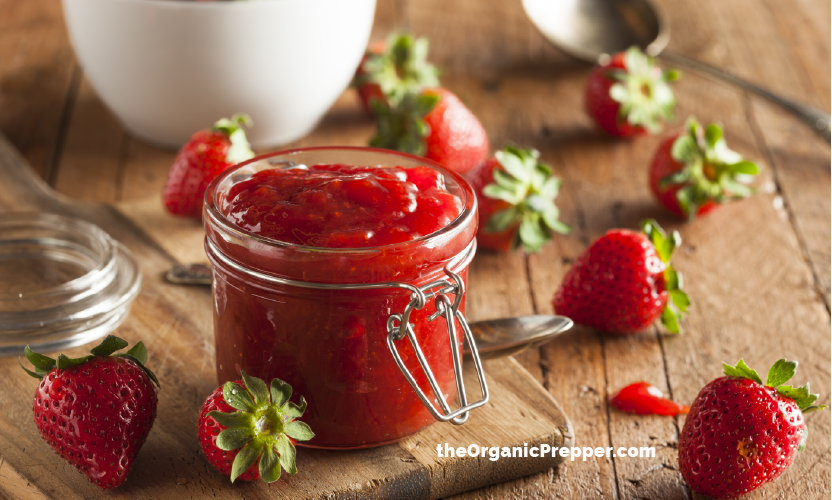
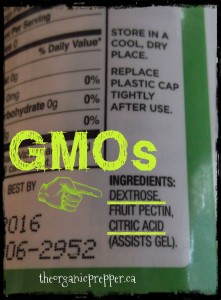
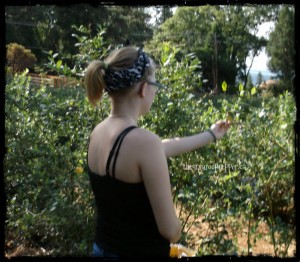
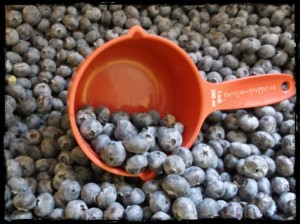
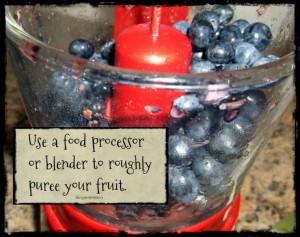
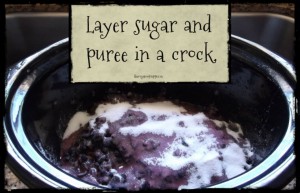
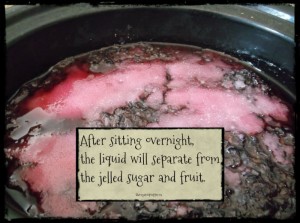

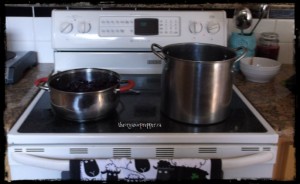
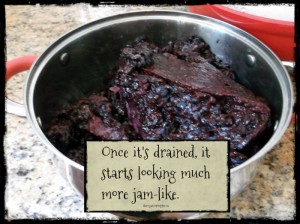
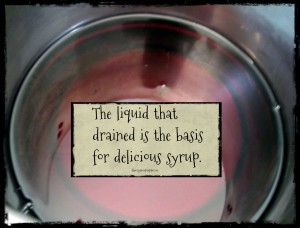
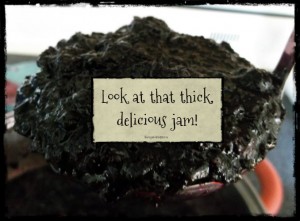
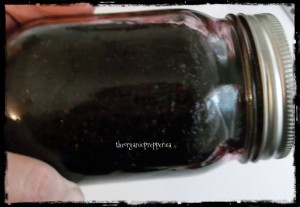















32 Responses
For those times or recipes that truly need pectin, go for Pomona’s Universal pectin. You can adjust the sugar to your desires, and even the amount of pectin to control the set better. They say “Pomona’s Universal Pectin contains only 100% pure citrus pectin, which is vegan, gluten free, and GMO free. There are no additives, preservatives, sugar, or dextrose. There are no corn or apple by-products.”
Great tip Rachel! I will have to look into Pomona’s
Pomona’s is great! I’ve always thought jam was unhealthy due to so much added sugar. But with Pomona’s, much less sugar, or no sugar, is used. I wouldn’t can jam without Pomona’s.
The biggest negative is that a given amount of fruit will produce less jam than in a regular recipe, due to lost volume from using much less sugar.
Also, It’s a bit more complicated to make. And sometimes, esp with a jar languishing in the fridge, the gel breaks down and the jam gets runny. But then, just pour it in a pan, re-boil it, pour it back in a jar, and it sets up thick again.
Easily available online at Pomona’s website.
I had thought that pectin was originally made from the cooked gelatinous leftovers from cartilage and joint material when people butchered. Maybe that is gelatin or “jello” as it is called by corporate America.
Good to know that every method of preserving food was originally done from scratch and not always “in a box”.
It’s something that needs to be passed on to the “young’uns”.
It is amazing what you find out on this site. Never knew that about pectin. I’ve make jam both with & without pectin. A few tips. I don’t know if saskatoons grow in the USA but if you put them through a grinder that breaks up the seeds a bit they are gelled when they come out of the grinder & you don’t need pectin. The seeds are a little bigger than blueberry seeds. I don’t know if other seeded berries would be the same.
Also the wild high bush cranberry if picked orange & crabapples have a lot of pectin & can be added to other fruit.
Years ago the Dept of Agric. in our province put out cookbooks on a number of topics including making jam & jelly & none of the recipes used pectin. I guess I will just have to dig out that book & try them again.
I rent an apt in a triplex that has an old plum tree in the back yard. I noticed that nobody was picking the plums even though they were good to eat fresh so last summer I decided to make plum jam. Hey, they are totally organic – no fertilizer, no pesticides/herbicides, no attention whatsoever lol I grew up on a farm where we made use of all the available wild fruit so I knew it wasn’t too complicated – plums cut in half & pitted plus sugar, boil until it looks like it is thickening then place in sterilized jars & water-bath for 10 mins. It set up beautifully with a very intense flavour that you cannot buy in a grocery store – no pectin needed. I guess it depends on your choice of fruit and/or your aversion to sugar but this is not something that we eat in large quantities or even every day so the amount of sugar is small price to pay for making use of free organic fruit without buying pectin.
Well, I wonder why it is such a big deal to do no pectin canning when no sugar canning seems to be nothing. Sugar has been implicated in many diseases, like obesity, heart disease, and diabetes. Yet pectin, not so much.
I completely understand people trying to get artificial and dangerous ingredients out of their lives. I do the same. But why target pectin instead of sugar? Which has way more evidence of health hazards? Esp considering the volume of sugar used in canning.
dianne mcc says that “the amount of sugar is a small amount to pay for making use of organic fruit without buying pectin”.
Seriously? The volume of sugar used in canning is far, far, much larger than the pectin used. Cups of sugar vs tbsps of pectin. Which is more toxic?
Consumption of sugar is strongly correlated with obesity and diabetes, and indirectly with other diseases. Sugar is not a safe substance. It plays havoc with blood sugar and blood insulin. There is evidence that it is highly addictive.
So, is a few tbspns of pectin worse? I think getting rid of sugar is a bigger issue than pectin. By far.
Fifty –
I think it depends on the type of sugar that you use. I recommend the purchase of a good quality organic sugar that has been processed as little as possible. Studies show that it is the highly processed white sugar that causes the issues you are referring to. It causes a true addiction because it stimulates the same part of your brain that heroin does. We scrupulously avoid this type of sugar, which is why we make all of our own goodies at home. I don’t want my kids having that kind of sugar – it causes huge cravings and all of the other issues you wrote about.
A less processed, pure sugar is different. I won’t go so far as to say it is nutritious but it isn’t detrimental like the stuff most people recognize as sugar.
This article only touches on the GMO issue but it does recommend some good sugar choices.
https://www.theorganicprepper.com/sweet-life-how-to-source-non-gmo-sugar-for-your-pantry-11282012
I usually agree with you whole-heartedly, but this time, I think it is an issue of the KIND of sugar a person consumes. In moderation, a less processed sugar is okay, in my opinion. 🙂
Daisy
Thanks for the thoughtful reply, Daisy. I agree natural sugar is better. I try to use honey, and I realize that occasional sugar treats don’t doom us. But I also think that sugar, per se, is not healthy.
I’ve been very influenced by scientist Gary Taubes and his article “Big Sugar’s Sweet Little Lies” as well as his books “Good Calories, Bad Calories” “and “Why We Get Fat”. He basically attacks the sugar industry for its history of hiding the part that sugar plays in a host of chronic and deadly diseases. I strongly recommend Gary Taubes works.
He also uses scientific studies to show that it is sugar, not fats, that makes us fat. Simplistically explained, eating sugar (or simple carbs) triggers the production of insulin, which, in turn, tells the body to store fat. The subsequent blood sugar crash, to make the new deposits of fat, triggers the appetite – to crave more sugary foods. And the cycle continues. Eating fats does not normally trigger insulin, and therefore doesn’t cause fat to be deposited, nor does it trigger intense food cravings like sugar does.
You’re very welcome! It’s always great having conversations like this, because everyone learns from them. 🙂 I will look for Taubes’ books the next time I have an Amazon spree – thank you for recommending them!
~ D
Have you heard of using Epsom Salt instead of pectin? Also, You can make your own pectin using organic apples. Directions are here from Canning Granny: http://canninggranny.blogspot.com/2011/09/making-and-canning-pectin-from-apples.html
Greetings, I appreciate your website and have found the comments informative as well. I stumbled across your article on making jam while looking into ways to prepare alternative yummies for my toddler. My son has a few food allergies and sensitivities, one of them is citrus intolerance. This year is the first in my life learning to cook from scratch & being mindful of ingredients. I’m going to try using blueberries and not sure if mangoes to jam (?) will work since both have low acid. I addes citrus juice rquired to make a jam? Thanks in advance, Anjelica 🙂
For sure, it’s always better to make it at home. For those who have time and are not very lazy 😀 Or try to find jams without unhealthy additives.
I stumbled across your site today and I absolutely love it! Really great tips!
I have never used pectin to make jam. My mother taught me that time and care while cooking can do it better. For any jam recipe, simply omit the pectin. While cooking, tediously scrape off any foam that bubbles up to the surface and place in a separate bowl. Keep boiling and scraping until the jam quits foaming and you’re left with clear thick jam. A quick test is to drop a dime size amount on a frozen plate, place in the freezer for 1 min, then run your finger through it. If it doesn’t come back together, it’s done 🙂
As an added bonus, most of the foam will settle back into yummy fruit syrup. I throw it in a jar and put it in the fridge for pancakes.
I cannot wait to try this! I’ve been making jam for ages, and am always open to a new healthier way or preserving foods. Quick question can this recipe be used for the more out there types of jams such as pepper jams, and other more decadent types?
Tracy:
It should be fine with liquid jams but may not work well for jams that include an added liquid ingredient, like alcohol. I think vanilla extract would be fine. I haven’t experimented with the fancier jams yet, but summer is coming and I definitely plan to!
~ Daisy
does this work with Great Lakes Gelatin Collagen Hydrolysate? Also do you know if i could use a sugar substitute and get the same result?
I’m not sure about the gelatin product. It should work with a sugar substitute, since you’re draining the fruit, but I’m not positive if it will gel properly. We don’t use any substitutes, but I’d be very interested in hearing your results if you experiment with it 🙂
I’m looking to make pepper jelly any suggestions
Hi, Kathy! Here’s my recipe for this:
http://www.theorganiccanner.com/how-to-can-sweet-and-spicy-peach-pepper-jam/
Thank you for the recipe. Do I have to store the canned jam in the refrigerator? How long does it last before spoiling? Thanks again.
Hi Yanyra – the jam will be shelf stable until it has been opened. Once you break the seal, you’d need to store it in the fridge just like storebought jam. 🙂 I hope you enjoy making it!
Hello, I have a degree in Chemistry and I used to work in a pesticide research lab – I view myself as an environmentalist – i love nature and I really respect planet earth. I think you might be confused here about the toxicity of pesticides. Let me just tell you that the coffee bean produces a pesticide called caffeine. Caffeine kills any little bug that tries to eat it – dead. Starbucks also sells caffeine in coffee for $4 a shot. This is the the strength of pesticides. They are biodegradable substances that are designed to leave the produce by the time of harvest. Scientists really are quite clever.
Also the 1-2 hours of boiling time you recommend for your jam would totally evaporate any minuscule and we are talking miniscule trace. We are talking parts per billion. To give you some idea of a part per billion, imagine the biggest beach you have ever been on, pick up a grain of sand ….thats your residue of pesticide that may have survived the storage process of the fruit and the biodegrading effect of the molecule. You are likely to receive much higher doses of benzene, lead and arsenic in the air that you breathe as you walk next to the traffic. You are also very likely to ingest toxins from your shampoo, toothpaste, drinking water and washing up liquid, air freshener, deodorant, and laundry powder. The amount of Thallium in kale is dangerously high. You really need a basic grasp of Chemistry to really understand how toxic a substance is.
Organic production is the worse threat to our remaining pristine environments and it is really disappointing that social elites who have very little education seem to demonise conventional agriculture . The farmers are not trying to kill us. Organic farms use many pesticides that are really not well tested and they use them at levels 1000 fold of conventional pesticides as they are not as effective. Please read about nicotine sulphate .
It would be a terrible shame to cut down the remaining rain forests on our planet in order to plant organic cucumber farms as the land use is often up to 50% more.
Please stop making conventional farming sound toxic and deadly, its really not. Go stand by the road and remember how much benzene is coming out of a car exhaust. You’ve been breathing it all your life. Please do a little research on the subject. I spent 10 years working in Chemistry.
I’m so glad I found your website! I, too, don’t like the ingredients in store-bought pectin and (in my case) have avoided making jam as a result. However, after doing a search for organic pectin, I stumbled upon your site. Thank you so much for sharing this! Now I’m excited to try making my very first batch of jam!
…am I the only person who actually tried this recipe out? There is no conclusion to the syrup. How long do I need to have it simmer? Good luck to me and my blueberry kitchen. I hope that I didn’t waist my wild blueberries.
Oh – sorry to leave you hanging, Brittany. The syrup cooks until it is the consistency you want it. That is because some people like theirs to be cooked down super-thick, while others prefer a thinner syrup for adding to beverages, etc. It is to be canned exactly like the jam – same amount of time. 🙂
I hope you enjoy it!
Hi Ms. Daisy!
I was wondering if you can give a recipe for strawberry jam-jelly. I stay away from all GMOs. I rather not use any pectin and the least amounts is sugar. I am new to canning, so any advice or products will be of great help. Also, how long can I keep canned jam-jelly for? (Still sealed) I only eat meat rarely and when I doit must be only grass fed, no antibiotics, hormones…I think you get where I’m going with this. Thank You so much.
Brenda
I don’t have a specific recipe for strawberry jam. But, you can use exactly the same process as above. Mash the berries with a potato masher if you like a chunkier texture in your jam. Then, add sugar and drain just like in these instructions. When it’s processing time, do so in a water bath canner for 10 minutes, adjusting for your elevation.
Sealed jams last for about a year, officially as per the USDA. However the sugar in them acts as an additional preservative and most of the time, jam can be used for far longer than a year.
Happy canning!
Daisy
iwant to make orange/pineapple marlade without pectin what do i need THAK YOU sally
I’m sorry – I haven’t made this myself, but if I’m not mistaken, most people use some of the natural pectin in the peel to thicken it up.
You mention using COTTON as a straining agent in your blueberry jam preparation; you might want to point out that cotton is now on the list of gmo products and we need now to find NON gmo cotton. Hope this is helpful; and thank you for the wonderful work you do.
Is this recipe specifically for blueberries (Huckleberries) or can it be used for all fruit. I love that I found this recipe of yours….as a child I mad jam with my dad, and I do not ever remember that we bought or used pectin, we merely cooked it till thick…Our favorite was Quince….and sometimes we cooked that for hours…but the smell was wonderful! Now I make my own, and sadly have been victim to the store bought pectins….so I am so very grateful for this recipe….Come Huckleberry season, I will let you know how it turns out!!!